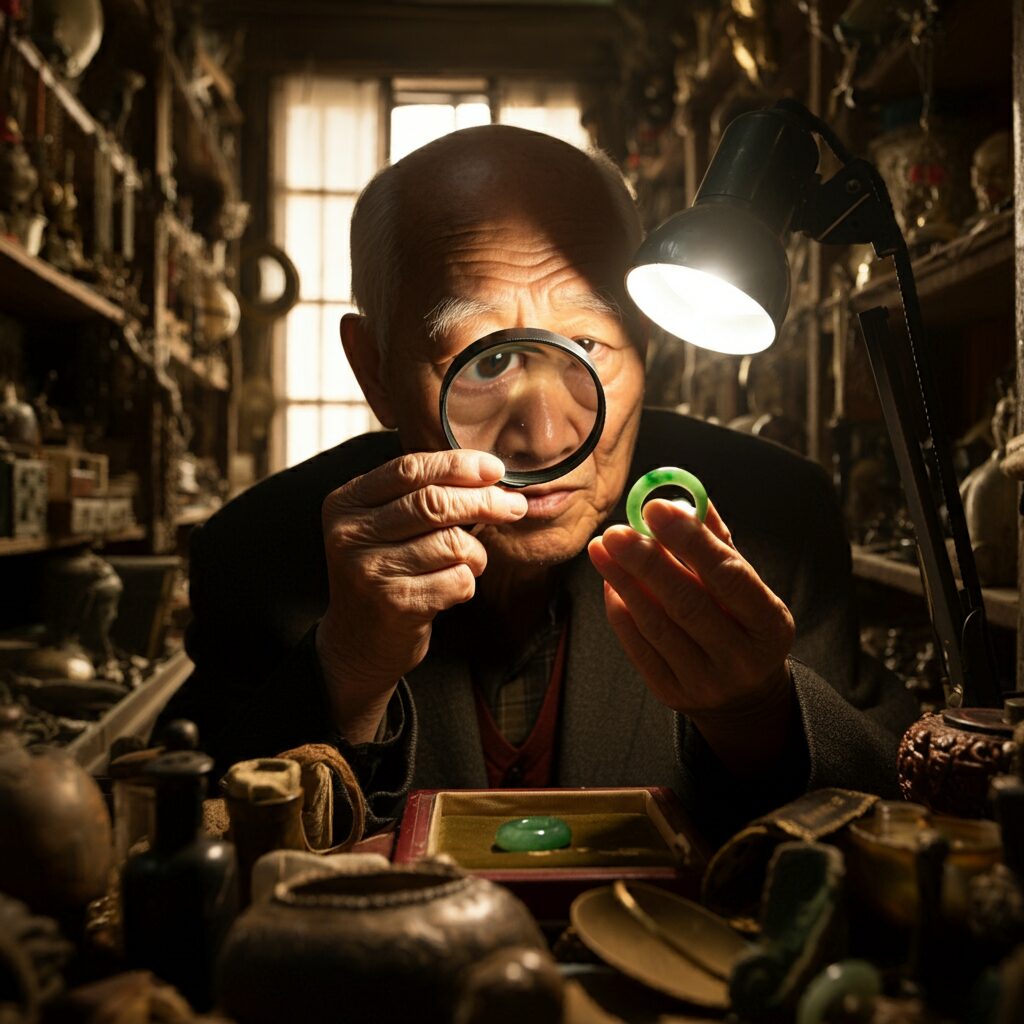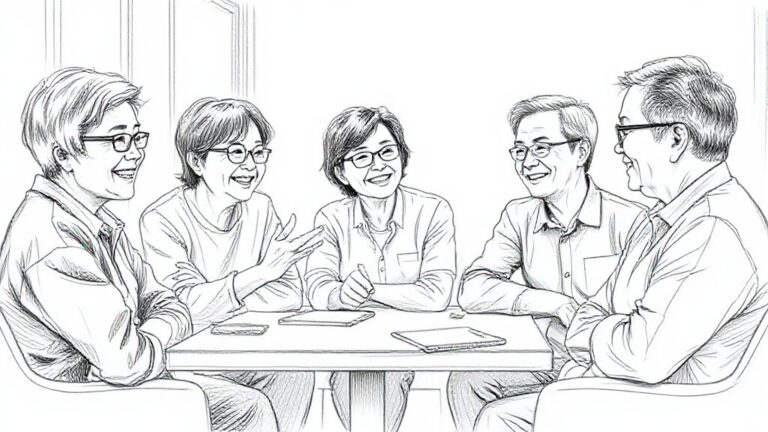2024-11-15 Progressive Story Building
Lesson Plan Explanation
This was made automatically with NotebookLM. I heard at least one mistake in their explanation. Can you figure out what they said wrong about the lesson plan?
[Man] 0:00:00
Hi, you’re learning English. It’s great. We want to help you learn. Today we’ll look at a fun way to learn English.
[Woman] 0:00:08
Okay.
[Man] 0:00:09
It’s a plan for an English class. We call this a lesson plan.
[Woman] 0:00:12
Right. A lesson plan is a teacher’s plan for the class.
[Man] 0:00:15
This lesson plan is called progressive story building.
[Woman] 0:00:18
Yeah, and it helps you learn step by step.
[Man] 0:00:20
You learn by building a story.
[Woman] 0:00:22
Exactly. This lesson is 90 minutes.
[Man] 0:00:25
90 minutes. That’s a long time.
[Woman] 0:00:27
Well 90 minutes is one hour and 30 minutes.
[Man] 0:00:30
Oh, I see. Richard made this lesson plan.
[Woman] 0:00:32
Yes, he did. Richard is a teacher. This lesson plan is for English learners like you.
[Man] 0:00:38
So this lesson is easy to understand.
[Woman] 0:00:40
Yes.
[Man] 0:00:41
It is. Great.
[Woman] 0:00:43
The lesson starts with a warm up. A warm up is a short activity before the main activity.
[Man] 0:00:46
It helps you get ready?
[Woman] 0:00:47
Right. Like stretching before you run.
[Man] 0:00:49
This warm up is called think pair share.
[Woman] 0:00:51
It takes 10 minutes.
[Man] 0:00:52
10 minutes.
[Woman] 0:00:53
Okay.
[Man] 0:00:54
First, you look at a picture.
[Woman] 0:00:55
A picture. Okay. It’s a special picture. It makes you think a lot.
[Man] 0:01:00
Provocative. Hmm. That’s a new word. What does provocative mean?
[Woman] 0:01:04
It means something that makes you think. It makes you ask questions.
[Man] 0:01:06
I see. So you look at this picture and then what?
[Woman] 0:01:09
You think. You look at the picture and you think about it for one minute.
[Man] 0:01:14
Okay. Think for one minute.
[Woman] 0:01:16
Then? You write three words about the picture.
[Man] 0:01:18
Hmm. Three words. Got it.
[Woman] 0:01:21
What’s next? Next you pair.
[Man] 0:01:23
Pair.
[Woman] 0:01:24
What does that mean? It means you talk to another student.
[Man] 0:01:27
Oh. So I talk to another person in the class.
[Woman] 0:01:30
Exactly. A student is someone who learns in a class. You share your three words with your partner. You tell your partner why you chose those words.
[Man] 0:01:38
I see.
[Woman] 0:01:39
So I explain my words. Exactly. And you listen to your partner explain their words. You do this for four minutes. Then what? Then some students share their words with the class.
[Man] 0:01:48
So they share with everyone.
[Woman] 0:01:49
Yes. This is for five minutes.
[Man] 0:01:51
Okay. So that’s the warm up. We think, we pair, we share.
[Woman] 0:01:55
Exactly. Now you are ready for the main activity.
[Man] 0:01:58
Sounds fun. What’s the main activity?
[Woman] 0:02:00
The main activity is progressive story building.
[Man] 0:02:04
Progressive. What does that mean?
[Woman] 0:02:06
Progressive means step by step.
[Man] 0:02:07
Okay. So we build a story step by step.
[Woman] 0:02:10
Yes. Story building means you make a story. This activity is 65 minutes.
[Man] 0:02:16
Wow. That’s a long time for the main activity.
[Woman] 0:02:18
Right. But it’s fun. We start with initial pairs.
[Man] 0:02:23
Initial pairs.
[Woman] 0:02:24
Mm-hmm.
[Man] 0:02:25
Initial means first. We work with a partner. We call this a pair. The teacher gives each pair some pictures.
[Woman] 0:02:31
Some pictures. Yeah.
[Man] 0:02:33
Then what happens? You look at the pictures with your partner. You make a story using the pictures. The teacher asks some questions.
[Woman] 0:02:39
Questions. What kind of questions?
[Man] 0:02:41
The questions help you make the story. The teacher might ask, who are the people in the pictures? Or what happened before this picture?
[Woman] 0:02:49
Mm.
[Man] 0:02:50
Interesting. The teacher could also ask, what is happening now? Or what will happen next?
[Woman] 0:02:54
I see. The questions help us use our imagination.
[Man] 0:02:57
Yes. And this takes 15 minutes.
[Woman] 0:02:59
So 15 minutes to make a story with a partner. Exactly. Then what happens? What’s the next step? Next is story combining. The teacher makes a group of four students. Two pairs are in each group.
[Man] 0:03:10
Oh, okay. So now we have a bigger group.
[Woman] 0:03:13
You have two stories, one from each pair. Now you combine the two stories to make one new story.
[Man] 0:03:19
Combine.
[Woman] 0:03:20
What does combine mean? It means to put together. You put the two stories together.
[Man] 0:03:23
So we mix the two stories.
[Woman] 0:03:25
Yes. We need to keep the important parts from both stories in the new story. This is a fun challenge. It takes 20 minutes.
[Man] 0:03:32
20 minutes to make one story from two. Sounds like fun.
[Woman] 0:03:35
It is. Then each group shares their new story with the class.
[Man] 0:03:39
So everyone listens to the stories.
[Woman] 0:03:41
Yes. Now the class has four stories. This is class story creation.
[Man] 0:03:47
Creation. What does creation mean?
[Woman] 0:03:49
It means to make something new. You are making a new story with the whole class.
[Man] 0:03:53
Wow. A class story.
[Woman] 0:03:55
All the students and the teacher connect the four stories.
[Man] 0:03:58
So we make one big story from four small stories.
[Woman] 0:04:01
Exactly. The teacher helps, but the students do most of the work.
[Man] 0:04:05
Hmm.
[Woman] 0:04:06
Like a puzzle. Yes. You put all the story pieces together. It takes 20 minutes.
[Man] 0:04:11
Okay. And after the story?
[Woman] 0:04:13
After the story, we look at language. This is language focus.
[Man] 0:04:17
Language focus. Okay.
[Woman] 0:04:19
What does focus mean? Focus means to look at something carefully.
[Man] 0:04:22
So we look at the language carefully.
[Woman] 0:04:24
Yes. So we look at the language for 10 minutes. The teacher helps the students fix any mistakes in the story. I see. The teacher also looks at the words the students used in the story. The teacher helps the students choose better words.
[Man] 0:04:36
Better words.
[Woman] 0:04:37
Yes. Words that help students tell better stories.
[Man] 0:04:40
So this helps students improve their English.
[Woman] 0:04:42
Exactly. The last part is closing reflection.
[Man] 0:04:46
Closing reflection. Hmm. What does reflection mean?
[Woman] 0:04:51
Reflection means to think about something.
[Man] 0:04:52
Okay. So we think about the lesson.
[Woman] 0:04:55
Yes. And closing means the end. This part is 15 minutes. Students talk to a partner about what they learned. Hmm.
[Man] 0:05:02
I like talking about what I learned.
[Woman] 0:05:04
Me too. Then students share with the class. They say one thing they learned from other students.
[Man] 0:05:09
That’s a great way to end the lesson.
[Woman] 0:05:11
I think so too. It helps students learn from each other.
[Man] 0:05:14
I think so too.
[Woman] 0:05:15
So that’s the entire progressive story building lesson. It takes 90 minutes. Wow.
[Man] 0:05:20
That was a lot of information. But it sounds like a fun lesson.
[Woman] 0:05:22
It is fun.
[Man] 0:05:23
I’m sure our listeners would like to try this lesson.
[Woman] 0:05:25
I think so too. It’s a good way to learn English.
[Man] 0:05:27
It’s fun.
[Woman] 0:05:28
Exactly.
[Man] 0:05:29
So we talked about the progressive story building lesson.
[Woman] 0:05:31
Yes, we did. It’s a good lesson.
[Man] 0:05:34
That’s a good lesson.
[Woman] 0:05:35
What do you like about this lesson?
[Man] 0:05:37
I like many things about this lesson. Students learn English. Yeah. And they learn about stories. Right. They also learn to work together.
[Woman] 0:05:44
Hmm.
[Man] 0:05:45
That’s important. Yes. Students talk to each other. They share ideas. They learn from each other.
[Woman] 0:05:50
That’s a good way to learn a language.
[Man] 0:05:52
It is. Sharing and sharing help us learn.
[Woman] 0:05:55
I agree. I like that this lesson uses pictures.
[Man] 0:05:58
Oh yeah. The pictures are great. Pictures help us tell stories.
[Woman] 0:06:01
They give us ideas.
[Man] 0:06:03
Exactly. And the questions are helpful too. They help students think about the story. Yeah. The teacher asks questions like, what is happening in this picture?
[Woman] 0:06:10
Right. And what happened before this picture?
[Man] 0:06:12
And what will happen next?
[Woman] 0:06:14
Yes. Those are good questions. They help us use our imagination.
[Man] 0:06:17
I like that this lesson is not just about making a story.
[Woman] 0:06:20
Oh. What do you mean?
[Man] 0:06:22
It helps you learn English too. The teacher helps students choose the right words.
[Woman] 0:06:26
Yes. That’s important. The teacher is like a guide. The teacher helps students. But the students do most of the work. Right.
[Man] 0:06:35
The students are the storytellers.
[Woman] 0:06:36
Exactly. They use their imagination. Hmm.
[Man] 0:06:39
Imagination.
[Woman] 0:06:40
What does imagination mean? Imagination means you think of new things. You think of creative ideas.
[Man] 0:06:45
Oh, I see. So students use their imagination to make the stories. Yes. I think this is a good lesson for learning English.
[Woman] 0:06:52
What do you think? I agree. It’s a good lesson. It’s fun and helpful.
[Man] 0:06:56
Maybe we can use this lesson in our next English class.
[Woman] 0:06:59
That’s a great idea. I think we’ll all learn a lot.
[Man] 0:07:02
Okay. So we talked about a lesson plan today. It was called progressive story building.
[Woman] 0:07:06
Right? Yes.
[Man] 0:07:08
That’s right. And this lesson can help you learn English.
[Woman] 0:07:10
Yes, it can. And it’s a good lesson plan for teachers too.
[Man] 0:07:14
Oh.
[Woman] 0:07:15
How does it help teachers? Well, it helps teachers plan their English lessons. It gives them lots of good ideas.
[Man] 0:07:21
That’s great. What part of this lesson did you like the best?
[Woman] 0:07:24
Hmm. That’s a good question. I really liked the stories. Making stories with other people is really fun.
[Man] 0:07:32
Yeah, it is.
[Woman] 0:07:33
And it helps you learn English too.
[Man] 0:07:35
It does. You learn new words when you make stories.
[Woman] 0:07:37
Exactly. And in this lesson, the students all share their stories with each other.
[Man] 0:07:42
Oh yeah. That’s a good idea.
[Woman] 0:07:44
Why is that good? Well, the students can learn from each other’s stories. They get new ideas for their own stories. That makes sense. And they learn new words from each other too.
[Man] 0:07:52
So everyone learns together.
[Woman] 0:07:53
Yes.
[Man] 0:07:54
Well, I think this lesson plan sounds really good.
[Woman] 0:07:56
Me too.
[Man] 0:07:57
It can help you learn English. It’s good for teachers. And it’s good for students.
[Woman] 0:08:01
That’s right.
[Man] 0:08:02
Well, it was really fun to talk about this lesson plan with you today.
[Woman] 0:08:05
I had a lot of fun too.
[Man] 0:08:06
I think our listeners will enjoy learning about progressive story building.
[Woman] 0:08:10
I think so too.
[Man] 0:08:11
It’s a fun way to learn. And you can learn a lot.
[Woman] 0:08:13
Yeah. And it helps you practice speaking English.
[Man] 0:08:15
That’s important. It is. Well, thanks for talking with me today.
[Woman] 0:08:18
You’re welcome. It was fun.
[Man] 0:08:21
Thanks to all of our listeners for joining us. We’ll see you next time for another deep dive.








RE: AI’s work
Is “This” in the sentence “This was made automatically with NotebookLM” the dialogue between [Man] and [Woman]? If so, does this mean that AI creates a dialogue for explanation from educational planning materials??? Then, I just have to say “Wow”
But at some places, I felt something wrong;
those are …..
1. The speakers of transcript are different from the audio data in some places.
For example, in a conversation where a female voice speaks, the transcript shows the speaker as [Man] and vice versa.
e.g.
Transcript:
[Man] 0:01:18 Hmm. Three words. Got it.
[Woman] 0:01:21 <> Next you pair. <- woman asks and woman answers
[Man] 0:01:23 Pair.
[Woman] 0:01:24 <> It means you talk to another student. <- ditto
Audio:
[Man] 01:18 Hmm. Three words. Got it. <> <- man asks
[Woman] 01:21 Next you pair. <- woman answers
[Man] 01:23 Pair. <> <- man asks
[Woman] 01:24 It means you talk to another student. <- woman answers
2. Transcript and audio match, but from the conversation flow, the speaker should have changed from woman to man???
[Woman] 0:02:59
So 15 minutes to make a story with a partner. Exactly.(<- this ‘Exactly’ was actually said by man.)
<> The teacher makes a group of four students. Two pairs are in each group.
<> woman asks and woman answers at both transcript and audio.
RE: One mistake “what they said wrong about the lesson plan”,
At 0:03:41, [Woman] says “Yes. Now the class has four stories.”, but at phase 2, two stories of same photo set are already combined into one new story, so the whole class has two newly combined stories, instead of four. Isn’t this the ‘one mistake’???
I couldn’t paste my previous post properly, so please discard it.
Try again.
RE: AI’s work
Is “This” in the sentence “This was made automatically with NotebookLM” the dialogue between [Man] and [Woman]? If so, does this mean that AI creates a dialogue for explanation from educational planning materials??? I just say “Wow”
But at some places, I felt something wrong;
those are …..
1. The speakers of transcript are different from the audio data in some places.
For example, in a conversation where a female voice speaks, the transcript shows the speaker as [Man] and vice versa.
e.g.
Transcript:
[Man] 0:01:18 Hmm. Three words. Got it.
[Woman] 0:01:21 “What’s next?” Next you pair. <- woman asks and woman answers
[Man] 0:01:23 Pair.
[Woman] 0:01:24 “What does that mean?” It means you talk to another student. <- ditto
Audio:
[Man] 01:18 Hmm. Three words. Got it. “What’s next?” <- man asks
[Woman] 01:21 Next you pair. <- woman answers
[Man] 01:23 Pair. “What does that mean?” <- man asks
[Woman] 01:24 It means you talk to another student. <- woman answers
2. Transcript and audio match, but from the conversation flow, the speaker should have changed from woman to man???
[Woman] 0:02:59
So 15 minutes to make a story with a partner. Exactly.(<- this ‘Exactly’ was actually said by man.)
“ Then what happens? What’s the next step? Next is story combining.” The teacher makes a group of four students. Two pairs are in each group.
“ ….. “ woman asks and woman answers at both transcript and audio.
RE: One mistake “what they said wrong about the lesson plan”,
At 0:03:41, [Woman] says “Yes. Now the class has four stories.”, but at phase 2, two stories of same photo set are already combined into one new story, so the whole class has two newly combined stories, instead of four. Isn’t this the ‘one mistake’???
If your Google (Gmail) account’s language is set to English, you can upload something to NotebookLM in any language and ask questions about it in English. If your account uses Japanese, you can ask questions in Japanese. It’s an absolutely amazing tool. Try uploading a technical paper PDF in English and you can interact with it in Japanese. It’s magical. More people should know about it.
For example, try one of these papers:
https://www.sciencedirect.com/science/article/pii/S1571064513001188
However, the AI podcast feature only works in English for now. I tried to hack it to work in Japanese, but the best it can do is read Japanese characters in Chinese. People have gotten it to work in a few European languages, but only English is officially supported.
The reason why the speakers aren’t always labeled properly, without getting too technical, is because I’m using free, open source software to convert the speech to text, then label the speakers. The technology is still under collaborative development by people from around the world, most of whom work on it without pay in their free time. If I used a different tool I’d probably get better results. I could have proofread the transcript but I’m too busy. Also, I was curious to see if anyone would notice. In other words, I was wondering if anyone from our class is actually reading this stuff I’m spending my time making.
I have another website where I’ve started using this technology to make listening & reading lessons for my private students. They choose the material and I use AI (and my brain–it’s not completely automatic!) to create individualized lessons that are interesting to them. One of my students is a Bob Dylan fan, another keeps honeybees, another is a 13 year old who likes insects, etc. I’m still experimenting–there are still lots of rough edges. So far, everyone has told me they enjoy studying this way.
https://lessons.starfishenglish.com
Thanks!!
I was able to understand the series of processes .
But I still do not understand the whole picture of NotebookLM, so as a first trial, I just uploaded lyrics of P!nk’s F**kin’ Perfect (looking at your another website 🙂 ) to see how it would work, or rather what would happen. Just like your Lesson Plan Explanation, two person’s conversation was created and it gave a deep explanation about the interpretation of the lyrics. As both audio and text file were provided, I could understand what they were saying word for word. I’ve always liked this song, but listening to their explanation, now I like it even more.
Their English is very colloquial, making it hard to understand if you don’t know the all the colloquialisms. Here’s a prompt I put in the “Customize” field to make them speak more simple (but still natural-sounding) English. It’s the button next to “Generate” or 作成:
Be brief.Listener is an adult beginner level English speaker.
Strictly use ONLY beginner level words and grammar.
ALWAYS explain the meanings of difficult & low-frequency words.
ALWAYS use simple past/present & present continuous.
Avoid idioms, phrasal verbs, & colloquialisms.
Avoid complex past tenses & multiple clauses.
Host & expert must not parrot or interrupt each other.
ALWAYS use contractions, e.g. say "don't", "you're" & "it's" instead of "do not", "you are" & "it is".